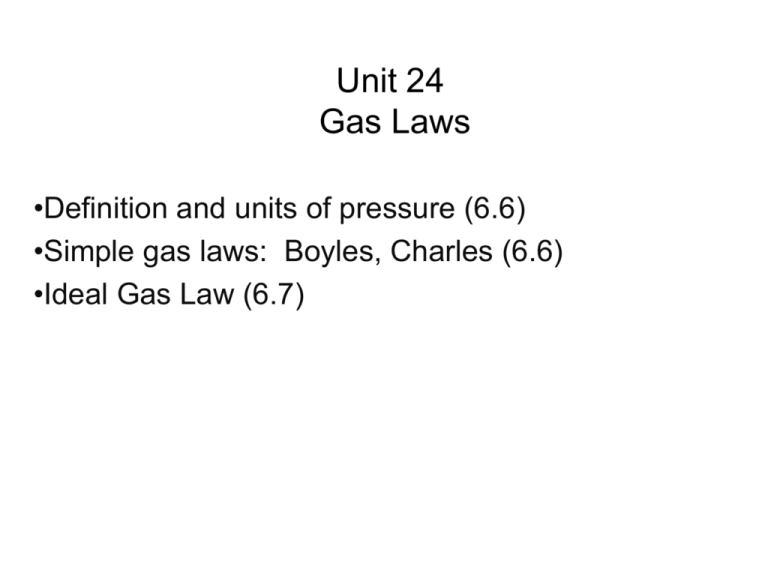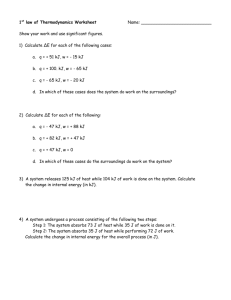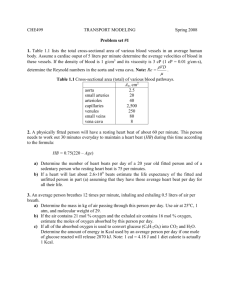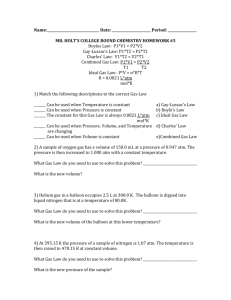Unit24 - Cameron University
advertisement

Unit 24 Gas Laws •Definition and units of pressure (6.6) •Simple gas laws: Boyles, Charles (6.6) •Ideal Gas Law (6.7) Accessing the PhET Simulation • • The next few slides use the simulation indicated here to illustrate the relationships between pressure and volume. Go to the site: http://phet.colorado.edu/en/simulation/gas-properties • • and click on either the Download button or the Run Now button. An image similar to that to the right will appear. Use your mouse cursor to raise the pump handle as high as it will go and then lower it. Watch the particles move around the container for a short while to get an impression of the particle motion. Do the particles move in straight lines between collisions? Does the motion appear to be random? Do you see any instances of a particle being “aware” of another particle other than during collision – do particles curve at all in their motion? Pressure Definition and Change in Volume Effect •Pressure is defined to be the force exerted on an area divided by the area. A simple example of pressure is to consider that, when filling tires, the units are usually in psi (or pounds per square inch). Thus, 1 psi corresponds to having one pound exerted over one square inch of tire. •In the gas simulation, each gas particle hitting the wall exerts a force on the wall. The more gas particles hitting the wall in a given period of time, the greater the pressure will be. •The units of pressure used in the simulation are atmospheres. Our normal atmospheric pressure is 1 atmosphere (or 14.7 psi). Effect of More Particles on Pressure •Under the Constant Parameter box in the upper right corner of the simulation click on temperature. •Make a note of the pressure (round gauge to the right of the box), temperature (thermometer stuck in the top of the box), and the number of particles indicated in the P n Gas in Chamber box just below the Constant Pressure box. •Raise the pump handle to full height one more time and bring it back down. Some questions to consider when you do this: •How did the number of particles change? •How did the pressure change? •On a particle level how would you explain this particle-pressure behavior? •Would a general statement be along the lines of “When the number of particles doubles at constant temperature the pressure also doubles”? •This sort of relationship, where any effect in one variable is seen to have the same effect on the other, is called a direct proportionality. •Mathematically, we could say P α n (where n is the number of moles of gas) or P=kn where k is a constant. Effect of Change in Volume on Pressure (6.6) •Hit the Reset button at the bottom of the right-hand pane in the simulation. •Select Temperature in the Constant Parameter box in the upper right-hand corner. •Make a note of the pressure (round gauge P n to the right of the box), temperature (thermometer stuck in the top of the box), and the number of particles indicated in the Gas in Chamber box just below the Constant Pressure box. •Click on the Measurement Tools box in the lower part of the right-hand pane. Choose the ruler. Drag the ruler so its left end is on the left edge of the box. Make a note as to how far to the right you would have to drag the left edge of the box to reduce the volume to one-half its starting value – it will be half the measured length of the box. •Drag the left edge of the box to the predetermined location. This will cut the volume of the box in half. •Answer the questions on the next slide. Effect of Change in Volume on Pressure Cont. •Questions to consider: •When you reduce the volume to one-half its original value, what was the effect on the pressure? •Is this relationship similar or opposite to that observed for the effect of changing the number of moles of gas on pressure? •How would you explain this volume-temperature behavior on the particle level? •Would a statement along the lines of “When the volume is reduced to one-half its original value at constant temperature and number of particles, the pressure inside the container doubles” be appropriate? •The behavior in this instance is called an inverse proportionality or inverse relationship. If one of the variables is doubled, the other is cut in half; if one is tripled, the other is cut to one-third, etc. A mathematical way of expressing this sort of relationship is to write: Pα 1 V or P = m V or PV=m (where m is a constant) These relationships hold only if both temperature and the number of moles of gas are constant. •This statement is known as Boyle’s Law, named after Robert Boyle who stated it in 1662. Volume-Temperature Relationships (6.6) •Hit the reset button in the simulation. Be sure the Constant Parameter box in the upper right has the None radio button selected. •Raise the pump handle as far as it will go and bring it down. •Make a note of the temperature and pressure. •Hit the Measurement Tools box in the righthand pane and select the ruler. Drag the ruler so the “0” marking is at the inside left edge of the box. Move the left edge of the box half-way across to the right. •Notice the pressure and temperature both went up. Now the trick is to return to the original pressure by reducing the temperature. Use the Heat Control below the box to reduce the temperature. Record the temperature at which the pressure has returned to its original value. Volume-Temperature Relationships Cont. (6.6) •Questions to consider: •By what factor did your temperature have to change to have the pressure return to its original value after the volume was halved? Did the temperature have to double, triple, get cut in half, etc.? •Do you suppose the same relationship would hold if you used the temperature Celsius scale? •On the particle level, why do you suppose you see this relationship between volume and temperature? •Is the volume-temperature behavior more like the particle-pressure or volume-pressure behavior seen earlier? •The temperature and volume both move in the same direction by the same factor. If the volume is cut in half, the temperature in Kelvin also has to be cut in half to return to the original pressure. This is similar to the direct proportionality seen earlier when considering the effect of changing the number of particles on the pressure. In summary, in situations where the number of particles and the pressure are constant: V α T or V = bT or V =b T (where b is a constant) •This is known as Charles’s Law named after Jacques Charles who stated it in 1787. Charles was a hot-air balloonist so had a natural curiosity about gases and their pressure-volume-temperature behavior. Summary of Gas Relationships (6.6) •The pressure-volume-temperature relationships above may all be summarized in one fairly simple mathematical relationship. Assuming the number of moles of gas remains constant (no gas escaping, forming, being added, etc.), the combined gas law may be stated as: PV PV 1 1 2 2 T1 T2 where the number of moles is constant •Mathematically, a few things might be helpful: •Units: The temperature has to be in Kelvin. The P and V units are not important as long as they are the same on both sides •Solving for missing information on the top is a matter of multiplying both sides by the denominator associated with the missing information and dividing both sides by the other member of the numerator. For example, to solve for P1 if everything else is known: PV T1 2 2 P 1 The solution process would be similar for V1, P2, and V2. T V 2 1 •Solving for missing information on the bottom can easily be done by first inverting both sides and then multiplying through by the denominator accompanying the missing T. The result looks like: T1 T2 PV 1 1 PV 2 2 Sample Problems (6.6) •A sample of a gas originally at 3.0-atm and 250 K is heated to 350 K at constant volume. What is its new pressure? •Given: P1=3.0 atm; T1=250 K; P2=?; T2=350 K Notice the volume is constant so V1 =V2 and we can leave them out of the combined gas law. P2 3.0 atm 3.0 atm P2 350 K 4.2 atm 250 K 350 K 250 K The pressure is larger as we would expect after heating at constant volume. •A sample of gas is originally at a temperature of 350 K, a volume of 45.0 L, and a pressure of 6.5 atm. What temperature is the gas at if the volume is changed to 65.0 L and the pressure is 8.0 atm? •Given P1=6.5 atm; T1=350 K; V1=45.0 L P2=8.0 atm; T2=?; V2=65.0 L T2 (6.5 atm)(45.0 L) (8.0 atm)(65.0 L) 350 K 350 K T (8.0 atm)(65.0 L) 622 K 350 K T2 (6.5 atm)(45.0 L) (8.0 atm)(65.0 L) (6.5 atm)(45.0 L) One Last Gas Law – The Ideal Gas Law (6.7) •In each of the previous gas laws one or more variables were held constant: •Boyle’s Law: •Charles’s Law: •Combined Gas Law: Number of moles and temperature are held constant Number of moles and pressure are held constant Number of moles is held constant •There is one relationship that ties together all four variables – none have to be held constant. It is the ideal gas law and is: PV nRT where P, V, n, and T have their usual meanings and R is called the universal gas constant. The value of R does not depend on anything – any of the variables or even what the gas is. •R can be expressed in a variety of units, but we will choose just one to work with. That value is R = 0.08206 L·atm/mol·K. •Sample problems are on the next slide. Examples of Use of the Ideal Gas Law (6.7) •What is the pressure of 0.50 mol of a gas confined to a volume of 110 L at a temperature of 325 K? P(110 L) (0.50 mol )(0.08206 L atm / mol K )(325 K ) P (0.50 mol )(0.08206 L atm / mol K )(325 K ) 0.121 atm 110 L •What is the volume of 1.0 mol of a gas at a temperature of 273 K and 1 atm of pressure? (1.0atm)(V ) (1.0 mol )(0.08206 L atm / mol K )(273 K ) V (1.0 mol )(0.08206 L atm / mol K )(273 K ) 22.4 L 1.0 atm •Notice this doesn’t depend on the identity of the gas. Under these conditions of temperature and pressure, commonly referred to as standard temperature and pressure (or STP), one mole of any gas occupies 22.4 L. •All of these relationships we have developed are strictly accurate only for a gas considered to be an ideal gas. An ideal gas basically follows the postulates of the kinetic-molecular theory. Most gases under rather ordinary temperature and pressure conditions follow these ideal gas laws – deviations occur at extraordinarily high pressures or low temperatures.









